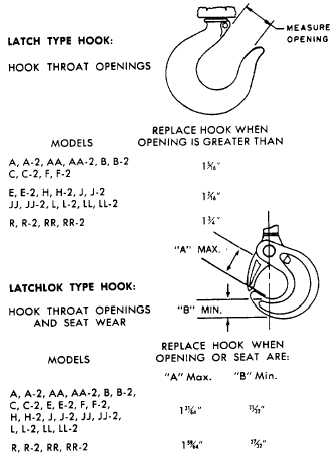f)
Inspect electric brake friction linings and friction
surfaces for wear, scoring or warpage. Check air
gap between armature and field. If the gap
exceeds 0.045 inch, adjust as described on
page 16.
g)
Inspect the liftwheel pockets for wear as
evidenced by a widening and deepening of the
load end of pocket. That condition will cause
the chain to lift up in pocket and result in binding
between liftwheel and chain guides. Severely
worn liftwheel should be replaced.
h)
Inspect the chain guides for wear or burring
where chain enters hoist. Severely worn guides
should be replaced.
i)
Inspect load chain, chain guides and liftwheel
pockets for clogging with foreign matter which
causes chain to bind. See hoist lubrication of
chain guides, liftwheel, lower sheave wheel and
load chain on page 16.
j)
Inspect trolley trackwheels for external wear on
the tread and flange, and for wear on internal
bearing surfaces as evidenced by a looseness
on the stud.
k)
Inspect collector wheels or collector shoes and
cotter pins for wear. Check the wheels and
studs for corrosion and free turning. Badly worn
parts should be replaced.
l)
Inspect the gasket between the gear housing
and back frame for signs of leaks. Tighten the
screws holding back frame to gear housing. If a
leaking condition persists repack housing and
gears with grease and install a new gasket.
Any deficiencies noted are to be corrected
before the hoist is returned to service. Also, the
external conditions may show the need for
disassembly
to
permit
a
more
detailed
inspection which, in turn, may require the use of
nondestructive type testing.
TESTING:
Prior to initial use, all altered or repaired hoists
or used hoists that have not been operated for the
previous 12 months shall be tested by the user for
proper operation. Test the unit first in the unloaded
state and then with a light load of 50 pounds times the
number load supporting parts of load chain to be sure it
operates properly and the brake holds the load when the
control is released; then test with a * load of 125%/e of
rated capacity.
In addition, hoists in which load sustaining parts
have been replaced shall be tested with * 125C%, of
rated capacity by or under the direction of an appointed
person and a written report prepared for record
purposes.
After this test, the function of the Protector is to
be tested. If the Protector permits lifting a load in
excess of 180%c of rated load it should be replaced.
* If the Protector prevents lifting of a load of 125%c of
rated capacity, reduce load to rated capacity.
NOTE : For additional information on inspection and
testing, refer to Code B30.16 "Overhead Hoists",
obtainable from American National Standards Institute,
1430 Broadway, New York, N. Y. 10018 U.S.A.
HOOKS:
Hooks damaged from chemicals, deformations
or cracks, or that have more than a 10 degree twist from
the plane of the unbent hook or excessive opening or
seat wear must be replaced.
Also, on latch type hooks, hooks that are
opened and allows the latch to disengage the tip, must
be replaced.
Any hook that is twisted or has excessive throat
opening indicates abuse or overloading of the unit.
Other load sustaining components of the hoist
should be inspected for damage.
Check to assure latch is not damaged or bent.
The charts below should be used to determine
when the hook must be replaced. On latch type hooks,
remove latch to measure opening. Be sure to replace
latch after measurements are completed.
FIGURE 11.
13

